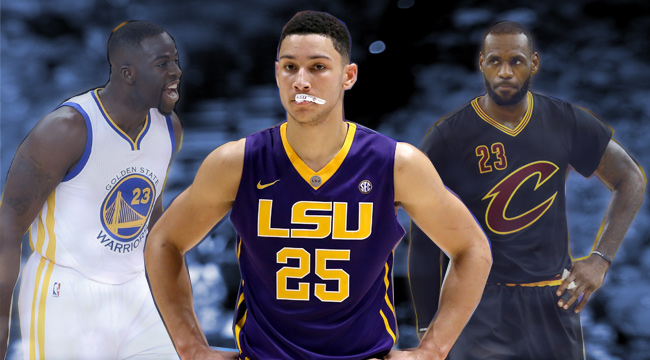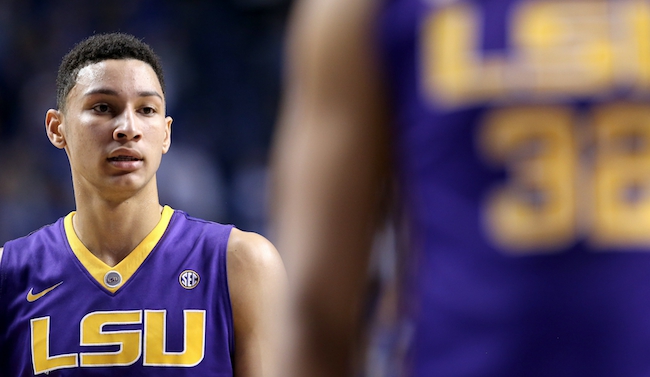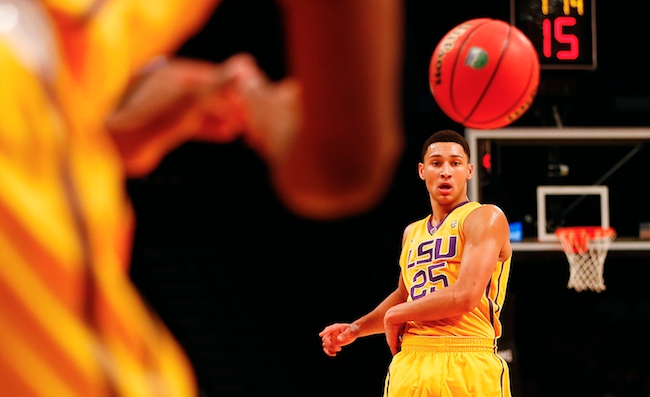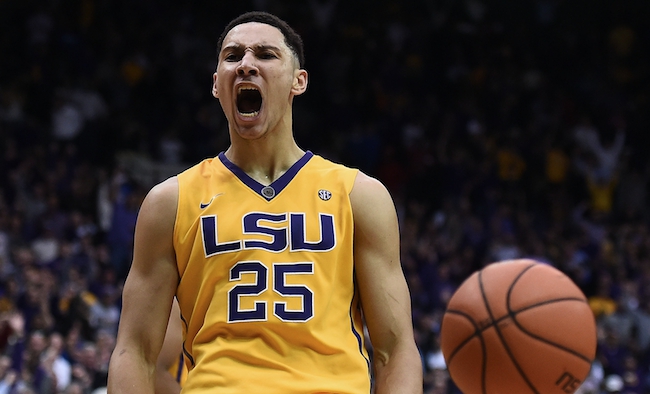
Ben Simmons intends to blaze his own path to stardom and seems unconcerned with burning any competition that will stand in his way of reaching that goal.
“I want to be my own player, and I’ve always wanted to be my own player,” the presumptive No. 1 pick in the 2016 NBA Draft told ESPN The Magazine. “When I was younger, I wasn’t a pro, but now I’m about to be a pro and it’s business, and I’m not looking up to these guys while I’m playing against them, no. I’m going at them.”
That sense of aggression is a trait many say Simmons was sorely lacking during the second half of his headlining freshman season at Louisiana State University. Clearly affected by his team’s long-shot NCAA Tournament hopes and criticism gleaned from a recent academic suspension, Simmons totaled 25 points, 20 rebounds, and six turnovers on 10-of-21 shooting over LSU’s pair of SEC Tournament games – solid numbers, but far from those he accumulated early in the season as he established himself as a runaway favorite for National Player of the Year.
Simmons didn’t win college basketball’s most prestigious individual honor. The Naismith Award went to Oklahoma Senior Buddy Hield, a fellow top-five draft prospect who embodied everything “right” about the college game as a senior, making marked improvements between each of his four years in Norman.

That’s not Simmons, obviously. He was billed as a one-and-done player well before he stepped on a college campus, played for a non-traditional hoops program that happened to employ his Godfather, and was the worthy and frequent recipient of “GPA! GPA! GPA!” chants from opposing crowds after his sub-2.0 grade point average became public information. Of course, Simmons single-handedly galvanized a dormant LSU hoops following and consistently awed adoring fans across the country with his unique blend of size, athleticism, and playmaking ability.
There hasn’t been a college basketball player since 2004 who personified all the benefits and pitfalls of the league’s minimum age requirement quite like this.
But the necessary evil of his one-sided relationship with the NCAA is over. Simmons is done with school, headed to the NBA, and will be drafted by the Philadelphia 76ers first overall on Thursday night at Barclays Center, barring a last-minute change of heart by Bryan Colangelo and company. The arbitrary limits placed on his basketball career are gone, replaced by the expectations inevitably shouldered by a teenager who is more deserving of comparisons to LeBron James than anyone before him.
Will Simmons make good on that limelight? It will be impossible to tell three or four years from now, let alone at the moment.
The universally accepted age a basketball player reaches his peak is 27. Simmons, at 19, almost a full decade removed from the time it will be appropriate to make any meaningful judgment on his career. But that it will prove so difficult to avoid doing so in the interim speaks to just how rare a prospect he really is.
When was the last time you saw a player with legitimate power-forward size make plays like this in transition?
*Note: Disregard the travel call in the second clip; that basket stands in the NBA.
https://i.giphy.com/k9VwQZp6AmNDW.gif
https://i.giphy.com/N4NhkG5J1bttK.gif
There’s an easy answer to that question, obviously: June 19, when James was leading the Cleveland Cavaliers to their first championship in franchise history with a stunning Game 7 victory over the Golden State Warriors.
Simmons, 6-foot-10 and a thickening 240 pounds, has the dimensions to play on the interior. But his advanced ball-handling exploits lend themselves to perimeter play, and his innate court sense and passing genius are characteristics normally reserved for a “true” point guard.
Players Simmons’ size just aren’t supposed to look this fluid with the ball in their hands.
https://i.giphy.com/awp9lFnMmH6rm.gif
https://i.giphy.com/JBLGFnc5JQ9fG.gif
He’s left-handed, by the way.
Finding holes in the game of a draft prospect who went for 19.2 points, 11.8 rebounds, and 4.8 assists per game on 56 percent shooting shouldn’t be easy. According to sports-reference.com, Simmons is the only player in the last 22 years to reach each of those statistical thresholds. That he played for a team with a decidedly lackluster supporting cast and persistently vexing offensive approach only makes those numbers more impressive.
Simmons’ utter lack of a threatening jumper, actually, does too.
He shot a dismal 32.9 percent from mid-range at LSU, per hoop-math.com, and attempted just three 3-pointers all season long. The space defenders consistently gave him to launch from outside is perhaps indicative of his shooting struggles more than anything else.
This is where Simmons’ resemblance to James ends. Streaky as his jump shot has been for over a decade and remained for the majority of the postseason, the newly-minted three-time champion is still one of basketball’s best shot-makers. James can connect on insanely difficult attempts whether his jumper is working or not.
Simmons, by contrast, routinely misfired on wide-open 17-footers during his brief collegiate appearance, and more often elected against taking them at all. He just isn’t a shooter right now. Does that mean he won’t be forever? Of course not. Simmons’ career is barely in its infancy, and shooting is the skill rookies often improve upon more than any other as they age into veterans. His innate feel with the ball is encouraging in that regard, too.
The strides Simmons must take to become a plus shooter, though, are too long for them to be considered anything close to a formality. But here’s the thing: That reality may not keep him from developing into a superstar, and certainly isn’t enough to make Philadelphia think twice about calling his name first on Thursday night.

The league’s emphasis on stretching the floor has never been bigger, but its premium on full-court playmaking and overall versatility might be even higher. Simmons brings more to the table from the latter perspective than any draft prospect since James. The influence of a player who occupies multiple offensive roles and guards multiple positions is sweeping.
How often have we watched James make hay as a small-ball power forward over the second half of his career? How many times did Draymond Green switch onto a dynamic ball handler without repercussion as the Warriors chased 73 wins? How many possessions per game does Blake Griffin serve as the Los Angeles Clippers’ primary playmaker, with or without Chris Paul on the floor?
The game has changed, and Simmons is better equipped to take advantage of that shift than any player in this draft class or the most recent before it. That doesn’t mean he’s the next LeBron James or even Draymond Green, but does ensure that he’s more than worth the hype – for now.
We’ll start to find out if Simmons can live up to it once his NBA career finally tips off in late October.







